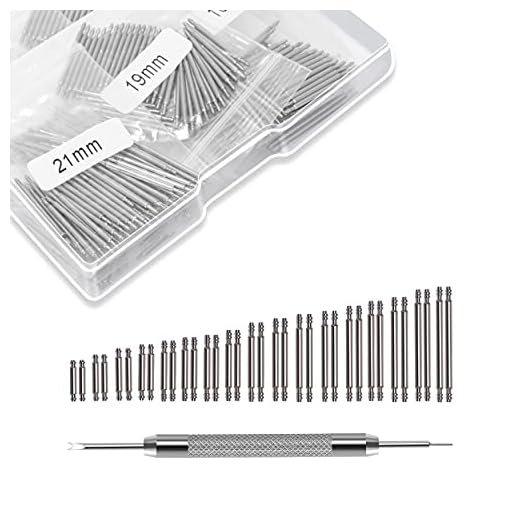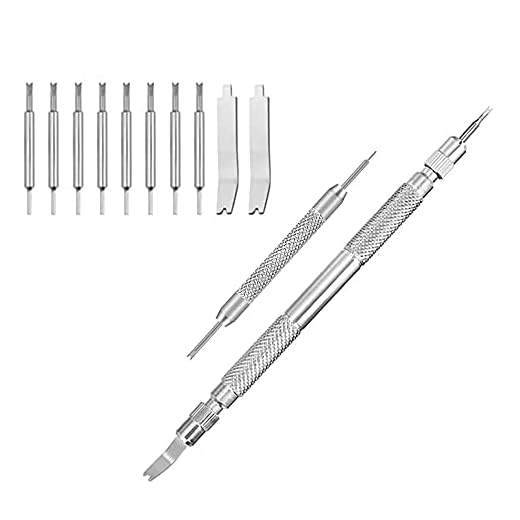Why Replace Spring Bars Yourself?
Replacing spring bars saves money, builds confidence, prevents watch loss. FUN FACT: a tiny failed spring bar can let a valuable watch drop and vanish. Learn safe, simple steps now.
Tools and Materials
Assess the Watch and Measure Spring Bars
Do you know your lug width? A millimeter mistake ruins straps!Examine the watch to identify lug width, endlink shape, drilled holes or recessed openings. Measure lug width with calipers or a ruler to the nearest millimeter — e.g., 18 mm, 20 mm — since this determines spring bar length. Measure spring bar diameter if replacing like-for-like and note whether bars are straight, curved, or have collars.
Inspect the strap ends for built-in spring bar ends or quick‑release pins. Clean the lugs and caseback area with a soft cloth to remove debris that can obstruct removal. Lay out tools and a soft working surface to avoid scratches.
Record these key details before buying replacements:
Photograph the assembly for reassembly reference.
Remove the Strap Safely
Ready to pop the bars? Don’t scratch your watch — here's how to do it like a pro.Place the watch face down on a soft pad or folded cloth with the lugs supported. Support the case to avoid twisting or scratching the crystal.
Engage the spring bar tool’s forked end against the bar shoulder and depress gently while guiding the strap away from the lug. Insert a flat screwdriver into the spring bar notch if you lack a tool and apply lateral pressure—avoid levering against the case. Work slowly so the spring bar mouth clears the lug hole without snapping free. Rotate the strap slightly or apply gentle counterpressure from the opposite side if the bar is stubborn.
Keep parts secure and organized:
Select and Fit Replacement Spring Bars
Don't guess — the right bar feels like it was made for your watch.Choose replacement bars matching your measured length and an appropriate diameter for the lug holes—common sizes: 1.5mm, 1.8mm, 2.0mm.
Prefer stainless steel for corrosion resistance and strength.
Use curved bars for curved or tapered straps and quick‑release bars only if both strap and watch accommodate them.
Inspect each new bar for burrs and clean with a soft cloth; remove any rough edges with fine emery if needed.
Insert one flange end into the lug hole, then compress the opposite flange with the forked tool while aligning the bar to the opposite lug; ease the flange into the hole until you feel a click.
Always seat one side fully before releasing tension on the other. Repeat the process for the second bar. If a bar won’t seat, recheck length and clear lug holes of dirt or old grease.
Consider replacing both bars at once to ensure even wear and security.
Install Spring Bars and Reattach Strap
Snap it in place — if it feels wobbly, it’s wrong.Fit one spring bar into the strap end or bracelet link so one flange engages the strap channel. Hold the watch firmly on a soft pad with the lug holes visible.
Compress the free flange with the forked end of the spring bar tool and guide it straight into the opposite lug hole. Keep the bar aligned—don’t cock it at an angle.
Once both flanges appear seated, gently wiggle the strap and press the bar inward to ensure full engagement. Perform a firm but controlled tug on the strap; there should be no sliding or popping.
Repeat the same process for the other side. For metal bracelets, ensure endlinks sit flush against the case.
If fit feels loose or asymmetric, remove and retry with the correct length or flange orientation. Stabilize the watch with a strap holder to prevent slips and protect case finishes during installation.
Inspect and Test the New Fit
Trust but verify — a loose spring bar can cost you an expensive watch.Visually inspect each spring bar with a magnifier, confirming both flange ends are fully seated in the lug holes. Look for gaps, uneven seating, or bent bars.
Move the strap through its normal range of motion to detect binding or unexpected looseness. Perform a series of gentle tugs and rotational tests—pull away, push inward, and twist slightly—to ensure bars remain seated. For example, tug as if catching the strap on a table edge and twist as when turning your wrist.
Wear the watch for an hour and periodically check attachment points during normal activity. If your watch is water resistant, avoid submerging it immediately; repeated strap work can disturb seals.
Maintenance Tips and When to Seek Professional Help
Save money with DIY — but know the red flags that mean it’s time to see a pro.Check spring bars during every strap change or battery swap.
Replace them every few years or sooner if corrosion, pitting, or visible wear appears — for example, swap bars that bend or show rust after normal use.
Use quality, appropriately sized bars; avoid cheap, thin aftermarket bars (e.g., auction specials) that bend or break easily.
Avoid excessive force when compressing bars and always use a correct forked spring bar tool to prevent scratching lugs.
Keep a small kit of common sizes (e.g., 18mm, 20mm, 22mm) and label spares for quick repairs.
Final Notes
With the right tools, careful measurement, and patience you can replace spring bars safely; keep records, inspect regularly, and seek professional help when unsure — try it and share your results.









Loved the maintenance tips. I’d add: apply a tiny dab of silicone grease to the spring bar ends if you swim a lot — helps a bit with corrosion.
Also, check the bars every 6 months if you wear the watch daily. Small checks = fewer surprises.
Good addition, Priya. A tiny dab of lubricant can help — just make sure it’s compatible with your strap material (leather vs rubber).
Does that grease mess with leather straps? I stopped using any oils on mine because they darkened.
Solid write-up. Quick question: when you say “measure from inside lug to inside lug,” do you mean center-to-center or the actual space? I always get confused and buy the wrong size.
Yep, measure the clear gap. If in doubt, tape a ruler across the lugs and read the inside edge — easier than trying to eyeball it.
Good question — measure the distance between the inside faces of the lugs (the clear space where the strap sits), not center-to-center. That gives the correct spring bar length to match the strap width.
Great guide — super clear! I was nervous about doing my own spring bars but the step-by-step made it doable.
I followed the measuring section carefully and ordered the exact size; strap slipped right on.
Tip for anyone like me: use a loupe or a magnifying light if you have shaky hands.
Also, that maintenance section saved me — I cleaned the lug holes before installing and it made a world of difference.
Agreed — the loupe trick is clutch. I keep one in my little watch kit now.
Nice! Which fastening tool did you use? The push-pin or the forked spring bar tool?
Thanks, Maya — glad it helped! Good call on cleaning the lug holes first, that’s often overlooked. If you want, share the watch make/model and I can suggest spring bar sizes commonly used for it.
Nice guide but practical question: what size kit should a beginner buy? There are so many spring bar sizes and tools out there.
Also, are tapered spring bars a thing I should care about? I feel lost in the tiny hardware jungle.
Tapered = fancy. Not necessary unless you’re dealing with vintage watches or strange endlinks.
Buy a kit that lists actual lengths (mm) and includes spare bars. Brands like Bergeon are pro-level, but there are decent budget kits that do the job.
I bought a small kit for $12 and it lasted me years. YMMV but the cheap ones worked fine for occasional use.
For beginners, a small kit with 16–24mm common lengths and a forked tool and a set of solid spring bars is a good start. Tapered bars exist but most straps use straight bars; tapered are more for cosmetic/curved endlinks. If you mostly have common straps, you’ll be fine with straight ones.
I keep a set of 1.5mm–2.5mm thickness spring bars and lengths 16/18/20/22 — covers 95% of my watches.
This guide is great but fyi, I made a dumb mistake: I didn’t push the spring bar in far enough before rotating the strap and it popped out mid-run. Ended up nearly losing my favorite watch 😩
So: always double-check fit with a nice tug test and visually watch the bar seat in the hole.
Also — carry spare bars when traveling. Saved me once when a bar bent on a bus.
PS: the tiny tools are dangerously easy to lose. I stick mine to a magnet strip on my bench now 😅
How hard is it to bend a bar? I assumed they were pretty sturdy.
They can bend if the wrong thickness or low quality. Stainless steel bars are usually fine, cheap ones can be weaker.
Great real-world reminder — tug tests are crucial. Glad you had spares when you needed them. The magnet trick is brilliant for tool storage.
Some constructive feedback:
1) Loved the photos, but an extra close-up of aligning the hole with the spring bar would help beginners.
2) The section on when to seek a pro is good, but maybe add examples of damage that definitely need a watchmaker (like bent lugs, stripped threads).
3) Maybe include a link to inexpensive spring bar length charts for reference.
Overall, very practical — just a couple of additions would make it perfect for absolute newbies.
I had no idea about stripped threads until I accidentally cross-threaded a screw bar. Learned the hard way 😂
Thanks, Olivia — that’s helpful. We’ll add a macro close-up and expand the ‘seek a pro’ examples (bent lugs, damaged endlinks, and stripped screw bars are great specifics). Appreciate the suggestions!
Agree with adding more ‘don’t try this at home’ examples — keeps people from making expensive mistakes.
Yes to the length charts — saved me once when I overthought everything.
Short and sweet — this was exactly what I needed. Clean instructions, no fluff. Replaced spring bars on three watches already and felt like a pro. 🙂
Haha, tried to do this without a proper tool and ended up inventing a very bad sculpture out of my spring bars. 10/10 would not recommend the butter knife method.
Ouch — the butter knife method is tempting but risky. If cost is the issue, a basic forked spring bar tool is inexpensive and worth buying.
Follow-up: I stripped a spring bar hole trying to jam a stubborn strap back on. The guide says inspect/tighten but not much about repairing nutured lugs. Anyone fix that at home?
If the lug hole is stripped (threads gone), it’s usually a watchmaker job — they can re-tap or fit a helicoil. For non-threaded holes where the bar sits in a smooth hole, sometimes a slightly thicker spring bar or a small sleeve works, but proceed with caution.